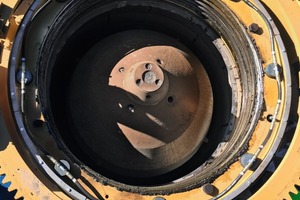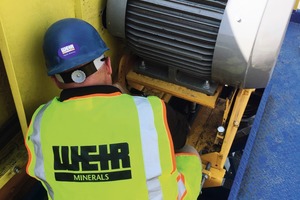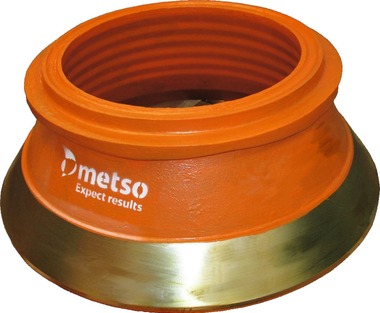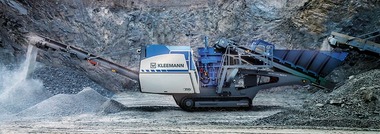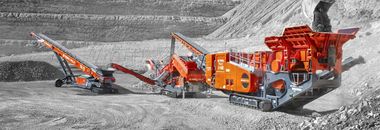Failure to adequately maintain crushers comes at a high price
The maintenance plan
Performing regular maintenance on crushers is integral to the reliability, performance and output they achieve. Prevention is better than cure; by carrying out regular inspections operators will ensure their crusher runs for a longer period of time with minimal unscheduled downtime. “The most important aspect is to have a maintenance plan in place and execute it. Following a maintenance plan and carrying out daily inspections can yield increased service life. This maintenance plan should adhere to the recommendations of the manufacturer,” states Eric Jones, Global Service Director of Comminution Aftermarket for Weir Minerals.
The maintenance plan may differ slightly, depending upon the machine, but most follow an initial 40 hour schedule post commissioning, followed by regular 250 hour inspection/maintenance intervals throughout the annual cycle. Within these intervals, there are prescribed tasks an operator will need to carry out. These include:
Checking the air filter to ensure the crusher is vented properly and that unwanted contaminates are not entering the breather
Checking the strainer basket on a cone crusher ensuring that there are no signs of excessive wear or damage to internal components
Greasing bearings if required to ensure proper lubrication and cooling of those bearings.
The consequences of inadequate maintenance inspections
If operators do not follow a maintenance plan and carry out daily inspections, it can have detrimental effects on the crusher. When it comes to insufficient maintenance inspections, the most common problems Weir Minerals has witnessed are premature bearing failures. For example, operators failing to notice that a breather has been knocked off, which fills the oil chamber with dust or debris; overlooking the grease line that has ruptured causing the bearing to no longer receive the required lubrication; or not checking the oil levels and having a bearing fail due to the lack of oil. These are all common problems which can be avoided if a full maintenance plan is put in place and adhered to.
Extending the life of crusher wear parts
Whilst wear replacement is a necessary feature of any crushing operation, there are steps operators can take to extend the service life of crusher wear parts. Eric Jones advises: “Always ensure the wear parts are fastened into the machine properly. With jaw crushers, if you allow the jaw dies to move during operation they can cause damage to the frame of the jaw crusher. Similarly, loose liners in cone crushers may damage the head or bowl.” It is also advisable that operators frequently look for holes, cracks, or flat spots, which could potentially damage the machine long term or be an indication of another issue.
Further to that, operators should track tonnages. As cone crusher liners wear, the operator threads the bowl inwards, bringing the bowl liner closer to the head which reduces the feed opening. The reduced feed opening may decrease crusher throughput at a cost; once that cost is greater than the price of the liner change the operator should consider changing the liners. At a glance, the liners may still have what an operator would perceive as usable wear left, but at a lost tonnage that doesn’t benefit the plant.
Detection of wear part damage
If an operator observes significant wear-part damage during regular inspections, they should consult the crusher manufacturer to find out if immediate stoppage is warranted. “Determining whether to stop production to change a wear part entirely depends upon the severity of the damage. For example, a damaged rotor tip in a VSI crusher may make it through the shift and not cause unwanted downtime. However, a broken jaw die with parent steel exposed may cause significant damage, and it is vital the operator stops the jaw crusher and change the die in order to protect the crusher frame,” says Eric Jones.
Common mistakes
Failing to take care of damaged wear parts can increase wear on the entire machine which can lead to expensive failures. A common misconception is that operators think they should wear jaw dies until they are completely flat or develop a hole or crack. By running these wear parts for a longer period of time, operators think they are extending the wear life, but in reality they may be causing unnecessary stress to the jaw frame.
Another common mistake Weir Minerals has witnessed is that operators run cone crusher liners past their useful operational life. The lost tonnages can cost the operator money greatly exceeding the amount that a liner change would cost,” states Eric Jones.
Safety is the no. 1 priority
Cone crushers have evolved from the earlier models introduced in the 1920’s, with most manufacturers now designing cone crushers with advanced hydraulic systems to raise, lower and adjust the machines safely with minimal effort. To clear a cone crusher, users simply depress a button, click the mouse or toggle a switch. This removes the risk of people manually clearing a stalled cone crusher by hand or using straps, chains and rolling stock to adjust their crusher.
“At Weir Minerals, safety is our No.1 priority and our latest designs reflect this. Our Trio TP cone crusher range is designed with self-protecting features to help achieve high levels of mechanical reliability under severe operating conditions whilst ensuring the safety of both the operator and equipment,” says Eric Jones. In addition, Weir Minerals’ latest Trio® CTHT series jaw crusher includes a hydraulic toggle relief system. This innovative, built-in system protects the jaw crusher from overloads caused by uncrushable material. The hydraulic toggle is designed to be a reliable and safe relief system, without unnecessary complexity for the operator.
$(LEhttp://

